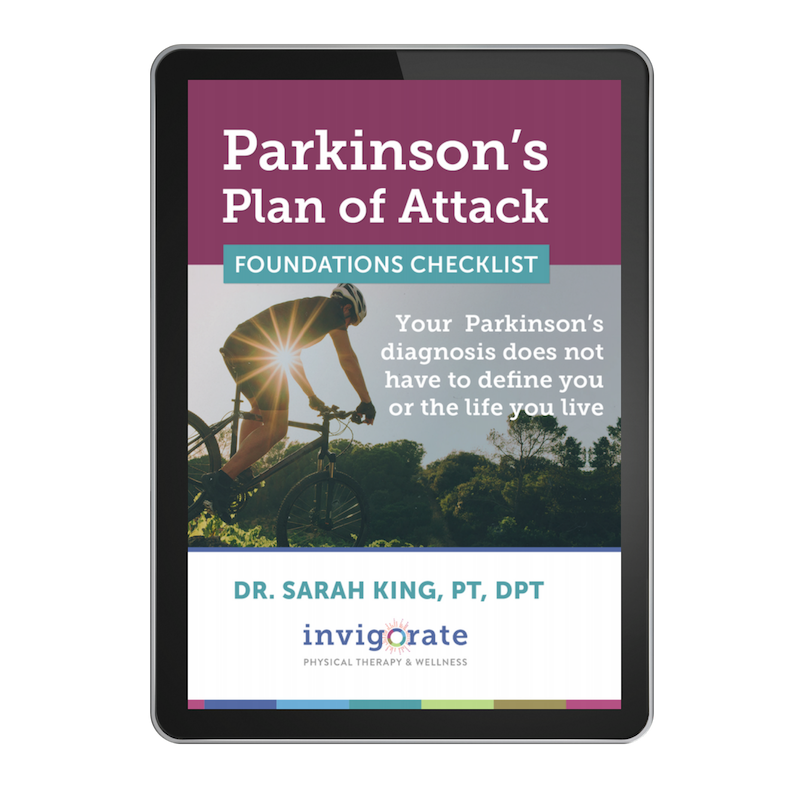At least once per year, videos highlighting the impact of cycling for people diagnosed with Parkinson’s circulate like wild-fire on social media.
One ABC News segment stars a man struggling with serious freezing episodes, who’s able to pedal effortlessly around the parking lot:
A second Nightly News segment shares how a cycling study at the Cleveland Clinic was able to help improve Parkinson’s symptoms by up to 35% by pedaling a bicycle at a rapid pace:
After people watch these, they usually reach out to me and ask:
...“Should I be cycling?”
...“Would getting on a bicycle help me, too?”
...“How do I even get started?”
The answer is: Yes, cycling could be a great option for you!
In this post I’ll walk through a variety of options for you to explore the benefits of cycling, no matter what stage of your Parkinson’s journey you’re in or your activity level.
WANT TO WATCH INSTEAD OF READ?
I covered this a recent Facebook LIVE broadcast over on the Invigorate Physical Therapy and Wellness Facebook page that you can watch here:
Here's an outline of what we covered (with time indicators) so you can go directly to what you're interested in:
3:30 - Stories in the news about Parkinson’s and cycling
5:20 - Most prominent cycling study for Parkinson’s
9:30 - What this prominent study tells us
10:25 - 7 Elements of a Highly Effective Parkinson's Exercise Program PDF Guide - www.InvigoratePT.com/7-elements-checklist
11:20 - A second study on passive cycling and Parkinson’s
15:35 - Your cycling options
23:40 - Introducing the Theracycle
24:30 - Introducing Rich Blumenthal with Theracycle
25:20 - Rich Blumenthal joins Sarah
26:50 - How Rich got involved with Theracycle
28:05 - What the Theracycle is and how it’s different
29:40 - Results seen with clients
33:50 - Adding effort for additional benefits with the Theracycle
35:35 - Who is best suited for the Theracycle?
38:15 - Difference between the 3 models
40:00 - Cost of the Theracycle
41:50 - Trying the Theracycle before buying it
42:00 - What happens if something breaks or if the customer doesn’t like it?
44:30 - Recommendations on how long or fast to ride
46:55 - How to gague your effort level
49:35 - Where to go for more information on the Theracycle
What’s the research say about Cycling for Parkinson’s?
Warning: Research geek-out in process.
(Not into research jargon? No problem, you can skip down to the next section. Just know that cycling has a serious impact on tremor, bradykinesia, and rigidity!)
LANDMARK CYCLING STUDY (2009)
Jay Alberts, a PhD neuroscientist out of the Cleveland Clinic published the landmark cycling for Parkinson’s study in 2009.
The goal of the study was to compare the impact of FORCED PACE exercise versus VOLUNTARY PACE exercise on Parkinson’s motor symptoms.
Both groups worked out for 45 minutes 3 times per week for 8 weeks total.
Both groups increased their heart rate (60-80% of their max heart rate) equally, except the FORCED PACE group was forced (via tandem bike) to pedal at a rate that was approximately 30% faster than their default, or voluntary pace. The VOLUNTARY PACE group, as you may have guessed, stayed at their default (voluntary) pace.
The results were pretty astounding:
Patients in the FORCED PACE group exhibited substantial improvements in their overall motor functioning compared to the patients in the VOLUNTARY PACE group, and the effects of the improvements lasted even after exercise was completed (approximately 8 weeks).
While both groups improved aerobically, the FORCED PACE group saw UPDRS scores* improve by 35% from baseline.
The FORCED PACE group also saw their rigidity improved by 41%, tremor improved by 38%, and bradykinesia improved by 28%.
In conclusion, “this data suggests that exercise rate or effort may be an important variable in improving motor function in people with Parkinson’s disease.”
*The UPDRS - Unified Parkinson’s Disease Rating Scale - is the test your neurologist has you do most often when you’re opening and closing your fingers and hands, and so forth, at your doctor’s visits.
As you can see, cycling at a pace slightly faster than what’s comfortable can pay huge dividends!
You can hear Jay Alberts talking more about this concept at the Davis Phinney Foundation’s Victory Summit here:
STUDY #2: WHAT ABOUT PASSIVE CYCLING? (2011)
A second study by Jay Alberts lab was performed in 2011 that looked at the impact of Passive Cycling on Parkinson’s symptoms.
Essentially they used a motorized bike that moves your legs for you and requires you to put 0% effort to move the pedals.
Participants heart rate was unchanged from warm-up, exercise, to cool-down as they put no effort into moving the pedals.
This study looked at how much time it took participants to complete the TMT-A and TMT-B tests, which are tests of cognitive function. According to Corrigan & Hinkleldey (1987), “the difference in the total time between TMT-A and TMT-B is highly correlated with intelligence and severity of (cognitive) impairment”.
The benefits of this study were less stellar, however there was evidence that cognitive function improved after cycling sessions.
The author’s concluded: “Although passive cycling is not expected to promote improvements in executive function as much as active exercise, this type of therapy could be useful for Parkinson’s patients who are unable to exercise in the recommended aerobic zones (60–80% of heart-rate reserve) because of disease severity, cardiovascular disease, muscle weakness, or other disability.”
What options are there for Cycling with Parkinson’s?
There’s something here for everyone!
ROAD RIDING
The first and most obvious is to dust off your bike and go for a spin around town.
You can ride solo and set your own pace, or add a challenge to go with a partner or a small group who can help push you outside of your comfort zone.
Riding tandem can be another great option, though it may be better for your relationship to try not to ride with your significant other. (Don’t say I didn’t warn you!)
Need a basic overview of bike riding?
Checkout REI’s Road Biking for Beginners Article here
INDOOR CLASSES
The next option is to take it inside.
Weather isn’t much of an issue in this setting, and because the bike is stationary there’s less anxiety about injuries. Plus, if your symptoms are more moderate and limiting, this is a very safe space to get comfortable with your wheels.
Check out your gym’s class schedule to see when they offer classes.
If you want a cycling coach that’s more familiar with Parkinson’s, you have a few options.
Pedaling for Parkinson’s has 90 different classes at YMCAs across the country:
Parkinson’s Cycling Coach has also trained 200+ coaches across the US that lead classes you can find via the search tool on their website here:
Click here for Parkinson’s Cycling Coach Class Finder
FUNDRAISING RIDES
The Davis Phinney Foundation is an incredible Parkinson’s non-profit that supports fundraising rides across the United States.
Find a Davis Phinney Foundation Fundraising Ride Here
One of their most popular races is RAGBRAI (Register’s Annual Great Bicycle Ride Across Iowa) which is a 7-Day ride where they pair up with Pedaling for Parkinson’s and represent what it means to “Live Well” with a Parkinson’s diagnosis.
THERACYCLE
TheraCycle is a motorized bicycle that some of you may heard of, and it’s a product I’ve seen my clients use in my private practice.
TheraCycle started at ExerCycle in 1932 and has grown and changed over the years, most recently specializing in producing motorized bicycles for clients with degenerative neurological diagnoses like Multiple Sclerosis and Parkinson’s.
They offer three models:
Theracycle 100
TheraCycle 200
and the Professional Model
I’ve seen the bike be a great supplement to a Parkinson’s-specific exercise program, give people a little energy boost and loosen up stiffness early in the morning or before exercise, and get people moving who otherwise wouldn’t have many exercise options due to the intensity of their symptoms.
The TheraCycle may be a good option for you, but it’s worth doing your research before investing.
I had the opportunity to interview the company’s COO, Rich Blumenthal, and talk through who may or may not be a good fit for their cycle:
We already knew that high-intensity exercise is extremely effective at helping you manage your Parkinson’s symptoms, and hopefully now you’re more clear on where cycling can fit into your program.
Make sure to download the free checklist I’ve created that covers the 7 Elements of a Highly Effective Parkinson’s Exercise Program PDF so you can ensure the exercise program you’re building isn’t wasting your precious time!
Download Your 7 Elements of a Highly Effective Parkinson’s Exercise Program PDF Checklist Here
Do you cycle? Do you plan to start?
I’d love to hear from you! What’s your experience with cycling for your Parkinson’s symptoms? Are you new and hoping to start adding it into your exercise regime?
Share in the comments section below!
REFERENCES
Brody, J. E. (2017, January 23). Exercise Can Be a Boon to People With Parkinson's Disease. Retrieved February 07, 2018, from https://www.nytimes.com/2017/01/23/well/exercise-can-be-a-boon-to-people-with-parkinsons-disease.html




